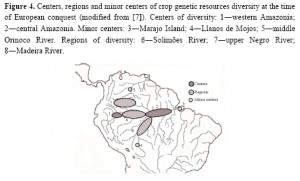I don’t know about you, but in my laziness I sometimes catch myself making the assumption that a centre of crop origin is also one of crop diversity. That is of course sometimes the case, but by no means always, as Vavilov himself recognized. A recent open access paper in Diversity makes the point very clearly. ((Clement, C., de Cristo-Araújo, M., d’Eeckenbrugge, G., Alves Pereira, A., & Picanço-Rodrigues, D. (2010). Origin and Domestication of Native Amazonian Crops. Diversity, 2 (1), 72-106 DOI: 10.3390/d2010072))
The authors, led by Charles R. Clement of the Instituto Nacional de Pesquisas da Amazônia in Manaus, review molecular studies and also bring in archaeological and other evidence in their discussion of the history of Amazonian crops. They come to the conclusion that these crops originated around the periphery of the region: “All but one of the species examined originated in the periphery of Amazonia (Figure 3), rather than along the major white water rivers where pre-conquest population densities were greatest.” Here’s that Fig. 3:
Now, in contrast, here’s where the pre-Columbian hotspots of diversity were to be found: “The major centers and regions of diversity are along the major white water rivers and in northwestern Amazonia, where ethnic diversity is extremely high.”
The explanation, according to the authors, is the length of time involved in the development of agriculture in the region.
Because crop domestication began thousands of years before food production systems became important, it is not at all surprising to see a dramatic contrast such as that in Amazonia.
Why was the Amazonian periphery such a focus of domestication?
It is possible that sufficient natural resources were available [in central Amazonia] so that the home gardens were such a small fraction of subsistence that they are difficult to find in the archaeological record. In contrast, in the headwaters of the same rivers in the periphery, less abundant aquatic resources may have increased the importance of home gardens.

